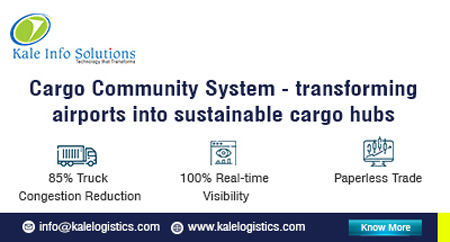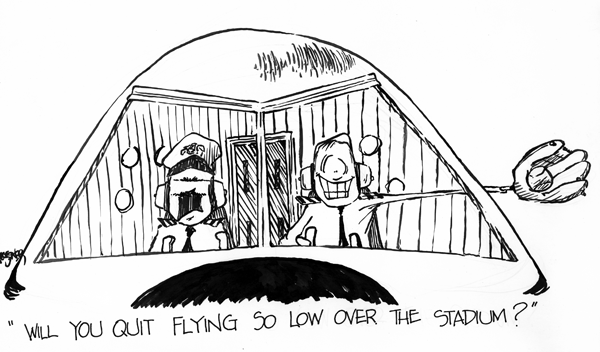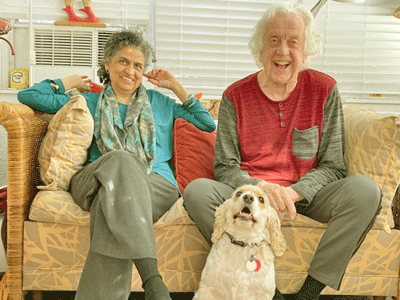 |
 #INTHEAIREVERYWHERE |
| Vol. 23 No. 43 | Thursday October 31, 2024 |
| |
 |
QCS-Quick Cargo Service based in Frankfurt founded in 1974 celebrates 50 years in business during 2024, but perhaps the bigger story here is that Quick Cargo founder Dieter Haltmayer, who has been in evidence at the company since he founded it, will be front and center celebrating his 90th birthday (October 31) at a big party in his honor November 2, at the Frankfurt Kempinski Hotel. In the picture with Papa Haltmayer, is Stephan Haltmayer, CEO, daughters Dr. Jennifer Melnyk, who serves in Finance for the company and Heidi Haltmayer, who serves as Director Administration. As QCS also celebrates 50 years of service in both air freight and sea freight, the personal touch remains the core business of based in Cargo City SUD at FRA and present at various locations. Quick with long-held traditions and family values, employs more than 400 in air and sea freight services as the company’s two-fold core businesses.
Quick Cargo enjoys a great reputation and is a member of the Federal Association of Forwarding and Logistics, FIATA International Federation of Freight Forwarders Associations and International Air Transport Association (IATA) (TOP 10 ranking). QCS which has embarked on a measured program of expansion in Eastern Europe has its own offices in the most important German and European economic regions. As a result of the continued growth and development over the last 50 years, QCS is present in 11 European countries with 28 offices. “Remaining close to customers is important so that in every case we can not only meet, but exceed our clients’ needs,” Stephan declared. GDA/SSA |
 |
Europe has many big, famous airports, but it also has smaller ones, and some of these, whilst they do not contain the volumes of Frankfurt, Paris or London offer more than decent services and function as vital constituents of their social and economic landscapes. At FT we have already featured AMS, BUD, BRU and others in the past. This time we feature an airport that serves one of the most beautiful, historic and fascinating cities in the world: Vienna. Once the capital of a very powerful empire, Vienna is a modern city with many attractions and one of the highest standard of living in the world. Having maintained a relevant role in UN’s activities, Vienna had also been considered as a possible seat for FIATA, when the discussion to move from Zurich took place in 2014. With a clear passion for music, I would have been more than happy to move to Vienna, if that were the decision taken. In fact, Vienna and music – in particular classical music – are intimately connected. Speaking of music, the title of this article might bring memories, as it coincides with the tile of a 1967 song written by Neil Young and recorded on May 6th of the same year. Another milestone in the Summer of Love, it was published as Buffalo Springfield’s second single, although none of the others of the band played or sang in the tape. So why am I saying this? Because expecting to fly is what we all do when we get to the airport (save those who work there). We arrive in a non-place to get to other places of our choice that are far from home. These are not just destinations for us, but often represent a dream, a desire, a discovery, a leap of our fantasy. Citing Marc Augé’s theory, Brian Eno exposed this concept of non-place in his music, when he composed the “Music for Airports” album: soft, quiet chords playing in the background of airports perceived as non-places. (Non) Places individuals remaining anonymous for one another share for travelling without any other implication than expecting to fly . . . In a way, the same process works for cargo. Our goods, whether we sell them, buy them or just handle them, use airports as a means to an end, guided by the “invisible hand” of our choices. The goods are not meant to stay in the airport, but they do, even more than we would hope. One could ask, why Vienna, why today? Well, we want to speak about Vienna airport in particular, because something interesting happened in VIE on October 22nd, as the airport itself put it: “Austria’s capital will once again serve as the meeting place for the air cargo and pharmaceutical sectors: Vienna Cargo Day and FlyPharma Conference at Vienna Airport in October 2024.” This is the information we read in their Press-Release: “Developing More Transparent, Resilient and Sustainable Supply Chains: aviation and pharmaceutical experts discussed current industry trends at Vienna Cargo Day and FlyPharma Vienna 2024. About 300 guests from the air cargo and pharmaceutical industries listened to the inspiring lectures and panel discussions.
Vienna Cargo Day examines challenges and opportunities in the sector In addition to the digitalisation of cargo handling and sustainable logistics solutions, the issue of artificial intelligence in supply chain management is one of the top trends in the aviation sector at present. Consequently, participants attending the Vienna Day Cargo were given a comprehensive overview of potential applications for AI, but also about its impacts on efficiency and innovation. The highlights included lectures by experts such as Glyn Hughes, Director General of TIACA, Sebastian Kummer from the University of Vienna and Sam Okpro from Pro Air Consulting. Exclusive insights about the positive cargo and route development as well as future perspectives on Vienna as a cargo location rounded the day off. After a short welcome by Ralph Rösener, Manager of Cargo Business Development of the Vienna Airport operating company Flughafen Wien AG, Günther Ofner, Joint CEO and CFO of Flughafen Wien AG emphasized the importance of the airport as an international flight hub. FlyPharma offered an exciting insight into the pharmaceutical and cargo sectors On 23-24 October 2024, the focus was completely on the field of pharmaceutical logistics and supply chains. Visitors to FlyPharma experienced two days full of ideas and impetus on market trends, innovations, the latest legal requirements, security technologies and promoting cooperation among different players. Experts such as Vatsala Sadasivan from Sanofi, Andre Majeres from IATA and Mark van Bakel from DHL Global Forwarding provided interesting insights. The Vienna Airport Pharma Handling Center (VPHC) is the airport’s own competence centre for handling temperature-sensitive air cargo.” Looking at VIE’s cargo page you quickly realise that this airport promotes its services as a gateway to Eastern Europe and beyond, and banks on IT to make it possible: “State-of-the-art data transfer: the infrastructure complies with the standards in the most modern data exchange and connects all partners in the transport chain by means of wireless LAN, barcoding and Edifact”. At FT we wanted to delve deeper into this idea: considering wireless LAN, barcoding and Edifact state of the art today might appear passé. Maybe not? Even at the glacial pace that air cargo is taking to evolve, sometimes airports seem to evolve more rapidly than their customers. That is why we have asked our contacts in VIE one question in this area: “What is your view of advanced analytics such as leveraging data techniques like machine learning (AI), deep learning (as a subset of machine learning), and does agile software development emerge increasingly important in general? Are you feeling any fatigue in your customers in the amount of data that they have to provide?” From the answers we have received from our interlocutors it is fairly clear that this is an area of great interest for VIE, where more time is needed even if we expect rapid evolution. Did I say glacial pace for air cargo to evolve? Maybe because of my personal frustration seeing on the one side the possibility to achieve unprecedented levels of efficiency by making the right investments in technology and the more than moderate speed at which this happens on the other: it took more than twenty years to get to the turning points we could already envisage at the UN in the ’90’s. And probably things would have been even slower, were it not for the enhanced security measures that became compulsory in the meantime. On the other side, perhaps airports evolved more and faster than the air cargo industry by expanding the boundaries of their own business. In the last few decades many airports have done much to upmarket themselves and become places where you do much more than expecting to fly. The economic power generated by the presence of an airport is such that many local economies should be thankful to the airport in the neighbourhood, often the main contributor to the local standard of living. Many struggle with aircraft noise, but for many others, who benefit from the airport’s offerings, these objects make all the right noises . . . Let me pay respect here to the memory of Juha Hintsa, who suddenly passed away this year. Juha has been one of my best Brussels colleagues in the security legislation related work. “It is making all the right noises” was his expression to say that the document we had prepared was good enough for submitting to the EU Commission. Let us remain in the airport security procedures. What we have witnessed in the last twenty-five years is an extraordinary makeover. Terrorism came onto airports as a devastating threat, so powerful that many were uncertain whether we could continue travelling as we had done in the past; many had doubts that airlines, and airports even more, could succumb to a harsher and more primitive life style. Fortunately, this did not happen, whilst security was implemented in gradual, powerful waves both in the air and on the ground. In these epochal changes, silently, and it seems to me with much intuition, airports have transformed themselves into attractive business centres, where all sorts of activities take place. When uptown shopping malls started losing their appeal, airports grew theirs. They modified their pathways to suit the new security requirements and added a good layer of glitz to their corridors. When we walk through the concourse we are all tempted to feel happy, ready for a holiday and we do not care if we spend a few bucks more than we should. The same goes for business travel: there are lounges offering relaxation, entertainment, fancy food and drinks. Arriving with a box of chocolates makes your business partners happy and friendly. There are several options to connect and work, and arrange meetings in the premises. For example, VIE features a very attractive Conference and Innovation Centre. Rather than remaining a non-place, the airport has become a place where you can actually live the high life, if you so choose, and in Vienna you can do this as if you were dancing the waltz . . . For the goods, airports are probably not so attractive as for passengers, yet we still have to register that flown cargo spends more time in airports and different stores than it does in the air, even though delivery automation is slowly progressing. In addition, congestion could affect some of the biggest airports: those are actually the first ones that come to mind, when we plan to ship our cargo, but even small airports may have their moments of glory, when you talk cargo. On Oct 6th 2024 an Antonov 124 landed in our small airport in Turin to load a Sentinel 1C satellite, locally produced by Thales Alenia Space. This is almost a feat in a town where the news is mostly about the next factory shutting down, which has an airport with fewer and fewer direct connections for cargo as a consequence.
Although much bigger than Turin, Vienna is comparatively smaller than the biggest, but it has a modern, well organised offer that can compete with the best. I personally flew through VIE many times and found all services that I ever wanted. Vienna Airport declares that it “is a certified EU airport of entry for: Food, Vegetables, Meat, and meat products, Fruits, Fish and fish products, Flowers, Live animals.” It also declares it is connected by “transport links. No other airport in the centre of Europe offers a denser and more reliable network of road-feeder transport to and from Eastern European cities. Vienna is the easternmost cargo hub to and from South-Eastern Europe in the European Union. The economy not only has regular scheduled truck services at its disposal, but also - if necessary - additional ad-hoc transports that can be quickly dispatched. These are specially designed to minimise transport time and thus perfectly meet the requirements of industry. Vienna International Airport also offers direct access to a motorway network leading to both the west and the east. The distance to important cities in the east and west is short.” What follows on their web page is a long list of connections to many European cities, showing the ambition to serve even farther destinations such as Amsterdam and Rome. So what’s next? “From 23-24 October 2024, the focus was completely placed on the field of pharmaceutical logistics and supply chains. FlyPharma participants received two days of ideas and impulses on market trends, innovations, the latest legal requirements, security technologies and promoting the collaboration of various players. Furthermore, an exclusive tour of the Pharma Handling Centre at Vienna Airport was offered.” If an airport can boast the existence of a “Pharma Handling Centre”, it clearly takes handing seriously. We actually wanted to know more on this issue and had asked VIE this question: “Why choosing to ship via VIE? What are the incentives, in particular, but not limited to procedures and transit times?” In reality the airport already published a straight answer to our question on its own website: “Advantages of handling through VIE: time and efficiency are two significant factors in the aviation industry. At Vienna Airport, services are constantly being expanded and improved to ensure the fastest possible handling of passengers, baggage and cargo arriving and departing. The advantages in detail: Speed, flexibility and minimum turnaround times. Depending on the type of aircraft, turnaround takes between 20 and 120 minutes. Perfect coordination and the greatest possible sense of responsibility; Permanent training of our staff; Control of the loading process through modern infrastructure; Guarantee of a high quality handling; ISO / TQM strategy to underline the commitment with quality; Quality control; Use of state-of-the-art technology.” But let us hear the airport’s voice in greater detail. Here are the straight questions and answers. Michael Zach, Senior Vice President Ground Handling and Cargo Operations and Wolfgang Scheibenpflug, Senior Vice President Real Estate and Landside Management have been our chaperons in presenting their exceptional infrastructure in further detail.
FT: What would you like shippers and logistics providers to know about VIE? Michael Zach: Vienna Airport (VIE) serves as a critical hub for cargo, especially as a strategic gateway to central and central eastern Europe. With direct access to a robust road network and short turnaround times for cargo handling, VIE ensures efficiency and reliability for shippers. Our excellent cargo infrastructure and well-trained staff is a huge advantage for the entire cargo community such as freight forwarders and airlines. FT: Why choose to ship via VIE? Michael Zach: VIE offers several advantages for shippers, including its strategic location in the heart of Europe, with 15 countries being reachable within one day of driving, and 23 countries within 1.5 days. This has facilitated the setup of a dense RFS network to the entire CEE region and to all major European hubs. Additionally, VIE's advanced and state-of-the-art infrastructure ensures minimal handling times, with cargo processing systems designed for safe and rapid turnover. The airport also supports a wide variety of services, such as temperature-controlled storage for pharmaceuticals and perishables, valuable goods storage, and 24/7 customs clearance, which ensures timely delivery of goods. These factors combined with modern handling facilities and streamlined bureaucratic processes make VIE a highly attractive option for shippers looking for speed and efficiency in cargo movement. We focus on extremely high-quality and special products such as pharmaceuticals and lithium batteries. Between January and September, we handled 3,079 tons of pharmaceutical goods, which represents an increase of 18 percent compared to the same period last year. Our Vienna Pharma Handling Center is GDP compliant and fully temperature controlled with a dedicated CRT and COL zone. It connects air- and landside directly and offers short apron distances to the aircraft. Exclusive truck docks (incl. ULD handling dock), dry ice and electricity charging services are available. Furthermore, this year, we successfully completed the IATA CEIV Li-Bat certification for our processes, infrastructure and trained staff. This step emphasised Vienna Airport's commitment to meet the growing demand for high-quality handling services for these product groups reliably, quickly and safely. FT: Future plans for VIE's air cargo operations and passenger interconnectivity: Wolfgang Scheibenpflug: Vienna Airport has positioned itself as a multi-modal hub, where cargo and passenger services complement each other. Future plans involve expanding its role in pharmaceutical logistics, with advanced facilities such as the Vienna Pharma Handling Centre. Our growth opportunities lie in Vienna’s gateway position to the CEE region for mainly Asian, but also North American and potentially South American and African markets. Automotive and electronics companies with production and distribution sites in our neighbouring countries have a strong demand for air freight traffic via Vienna Airport. There will be also a focus on special cargo products like pharma and lithium batteries. The growth in cargo operations is expected to align with passenger activities by optimizing transit times and using shared infrastructure, thus creating a seamless flow of both goods and people through the airport. This focus on synergy aims to support both growing air cargo demand and passenger services. FT: Is VIE ready for more air cargo gatherings and expansion? Wolfgang Scheibenpflug: Yes, VIE is not only prepared but actively expanding its involvement in the air cargo sector. Hosting events such as the Vienna Cargo Day and the FlyPharma Conference further highlights its growing role in the industry. This year, around 300 participants from the air cargo industry took part in the event and discussed trends such as AI for the supply chain, global market developments and innovations for air freight and pharmaceutical handling. This popularity underlines the growing interest and relevance of Vienna Airport as a central cargo hub in Europe. The airport's recent partnerships, such as with Incheon International Airport and Korean Air, underscore its commitment to expanding its cargo operations. Additionally, ongoing infrastructure developments, like the expansion of cargo centres, ensure VIE is equipped to handle increasing cargo volumes and support future industry events. The available handling capacity is meanwhile up to 350,000 tons per year, which created potential for further 90,000 annual tons in regard of the previous tonnage. With a dedicated cargo sector, Vienna AirportCity is the most attractive and best-known business location in Austria. Urban and modern facilities provide an attractive business environment for air cargo entrepreneurs regarding office and warehouse spaces, conferencing and event locations, numerous hotels, and gastronomy. FT: View on advanced analytics and AI in logistics: Michael Zach: AI will be one of the major topics in the cargo industry. Many companies are already starting projects to support Customs clearance processes with AI. We are also seeing an intention to automate or at least support special processes like DG checks. But far more AI will change the usage of warehouses in regard of storage optimization and autonomous transports. We have always invested in digital interfaces to improve and accelerate communication between handling, customers, and authorities. The latest Import One Stop Shop – IOSS module has created the perfect setup to process eCommerce shipments in a speedy and efficient way.
FT: Surprises post-pandemic and key lessons learned: Wolfgang Scheibenpflug: Post-pandemic, Vienna Airport observed a significant shift in cargo demand, especially for pharmaceutical goods. A key lesson has been the importance of flexibility – whether it's adapting infrastructure quickly or managing fluctuating demand. This experience has reinforced Vienna Airports commitment to investing in technology and expanding facilities to handle such shifts even more efficiently in the future. Another important topic is and remains sustainability. Since 2023 Vienna Airport runs its operation CO2-neutral and due to a number of measures it will achieve its goal of net-zero operation until latest 2033. For example, Austria's largest photovoltaic plant was commissioned at Vienna Airport in 2022. It is 240,000 square meters in size. 55,000 panels provide an output of 24 megawatts peak. This enables the airport to cover about 50 percent of its annual electricity consumption.” Coming back to our initial thoughts, my conclusion now is that VIE surely is everything else but a non-place. It is a business centre that significantly contributed to the development of its region. Although Vienna is a city that has a status which is independent of its airport’s fortunes, VIE is indeed a pretty dynamic place where you can do business and find appropriate solutions. VIE has punctual, appropriate answers to disclose the most interesting aspects of this attractive airstrip to a wide audience. Airstrip? Yes, that is how it all started: a wartime airstrip. If you try to understand more about VIE’s history this is what your internet connection returns to you: “originally built as a military airport in 1938 and used during World War II as the Heinkel firm's southern military aircraft design and production complex, or Heinkel-Süd facility, it was taken over by the British in 1945 and became RAF Schwechat under the occupation of the country.” Made through times of war, today’s modern airport propagates the peaceful melody of its seamless connections toward the East. All we need to do is to listen to the harmony of its contained ambitions, so different from the incontrollable appetites of this day and age, and start dancing at its exclusive 3/4 waltz beat. Marco Sorgetti Turin, October 25th 2024 |
|
|
 Click,
Look & Listen Playlist . . . Here
easily accessed on YouTube is a playlist of music that felt good to Sabiha
Geoffrey & Lulu looking up recently at the full moon, recalling the
Harvest Moon that occurred September 17-18, so here we go again celebrating. Click,
Look & Listen Playlist . . . Here
easily accessed on YouTube is a playlist of music that felt good to Sabiha
Geoffrey & Lulu looking up recently at the full moon, recalling the
Harvest Moon that occurred September 17-18, so here we go again celebrating.Frost is on the pumpkin and Halloween children wait in the wings for October 31st when according to JM Barrie who wrote Peter Pan, “All the world is made of faith and trust and pixie dust.” Summer’s Gone but you can feel the magic that lies ahead for the remainder of the year, this Autumn in New York City. Enjoy! GDA |
 |
If
You Missed Any Of The Previous 3 Issues Of FlyingTypers Access complete issue by clicking on issue icon or Access specific articles by clicking on article title |
||
 Vol. 23 No. 40 Bright Ideas During A Dock Strike Chuckles for October 2, 2024 Buffalo Airways Cargo Barges Ahead |
 Vol. 23 No. 41 The Future At Your Fingertips FIATA President In The Corridors Chuckles for October 10 This BUD Is For You Johan Martin Schröder Matters |
 Vol. 23 No. 42 Lionel van der Walt Goes Digital Chuckles for October 15, 2024 From Nicolette News You Can Use S'More Spohr Takes Wings |
Publisher-Geoffrey Arend • Managing
Editor-Flossie Arend • Editor Emeritus-Richard Malkin |
Send comments and news to geoffrey@aircargonews.com
|